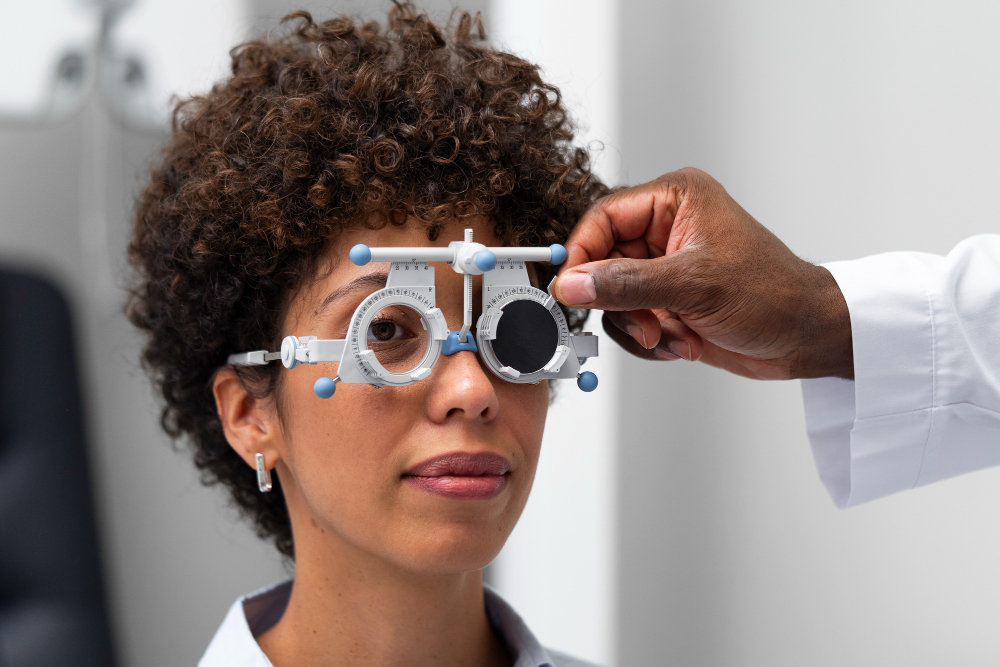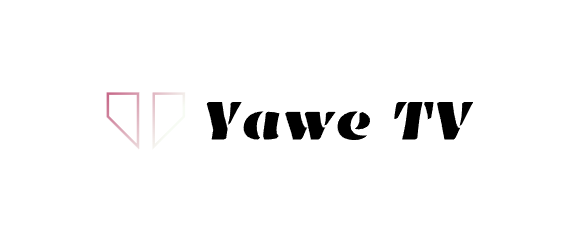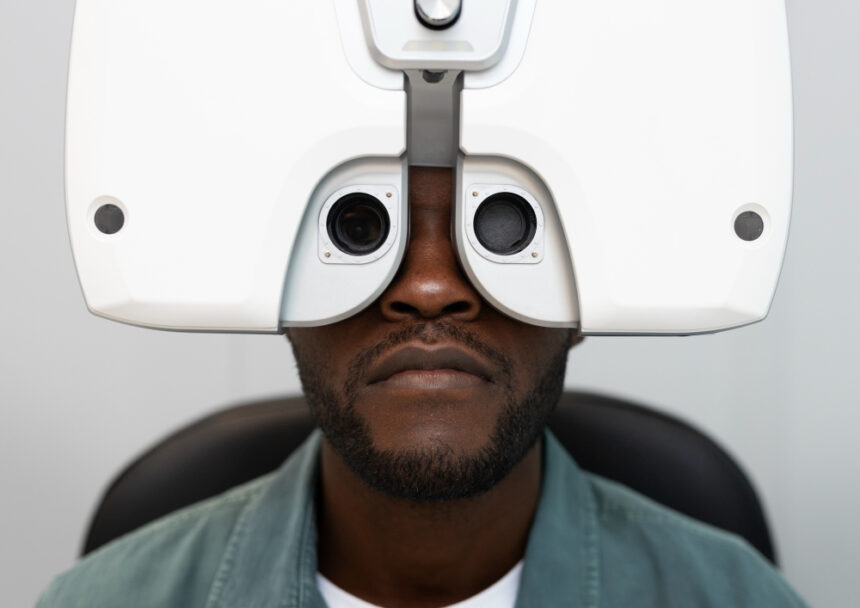When most people think of vision problems, the first symptom that comes to mind is blurry sight. It’s a classic sign that your eyes are struggling to focus, possibly due to nearsightedness, farsightedness, or astigmatism. But vision issues go much deeper than simple blurriness. Behind the scenes, some problems may be silently affecting your eyes, causing strain, discomfort, and even increased intraocular pressure. One often-overlooked culprit? Refractive errors.
While blurry vision is the most recognized symptom of refractive errors, these common eye conditions can have a far more complex impact than many realize. In this article, we’ll explore how vision problems—especially refractive errors can affect the health of your eyes, potentially leading to elevated eye pressure. Understanding this connection is vital not only for managing your vision but also for protecting yourself against more serious conditions like glaucoma.
What Are Refractive Errors?
Refractive errors are among the most common types of vision problems. They occur when the eye cannot properly bend or refract light to focus it directly on the retina. This results in images appearing blurred. The four main types of refractive errors are:
- Myopia (Nearsightedness): Objects nearby appear clear, while those far away look blurry.
- Hyperopia (Farsightedness): Distant objects are usually seen more clearly than close ones.
- Astigmatism: Vision is distorted due to an irregularly shaped cornea or lens.
- Presbyopia: Age-related difficulty in seeing things up close, typically appearing after age 40.
While these issues are easily correctable with glasses, contact lenses, or surgery, what often goes unmentioned is their potential impact on eye pressure and overall ocular health.
Beyond Blurry Vision: Subtle Symptoms of Refractive Errors
Most people associate refractive errors solely with blurriness. However, these vision problems can cause a wider range of symptoms, many of which are subtle and easily overlooked. Some individuals may experience persistent headaches, eye strain, fatigue, and difficulty focusing for extended periods. Others report dryness or even a sense of pressure behind the eyes.
These symptoms aren’t just annoying they can be warning signs that your eyes are under stress. Eye strain from uncorrected or under-corrected refractive errors can lead to a chain reaction of physiological responses. One of the more concerning outcomes is increased eye pressure, also known as intraocular pressure (IOP), which can elevate your risk for developing glaucoma.
How Refractive Errors Affect Eye Pressure

The relationship between refractive errors and eye pressure isn’t straightforward, but it’s increasingly gaining attention among eye care professionals. Here’s how the link works: when your eyes constantly struggle to focus due to a refractive error, the extra effort can lead to ocular fatigue and stress. Over time, this stress may disrupt the normal flow of aqueous humor—the fluid that helps maintain eye shape and nourishes ocular tissues.
When this fluid doesn’t drain properly, pressure within the eye can rise. High eye pressure itself is not a disease, but it is a risk factor for glaucoma, a condition that damages the optic nerve and can lead to irreversible vision loss if left untreated.
Myopia, in particular, has been associated with a higher risk of increased intraocular pressure. Highly myopic individuals tend to have longer eyeballs, which can affect the eye’s drainage system. This anatomical difference may predispose them to elevated pressure levels and, subsequently, glaucoma.
The Overlooked Link Between Vision Problems and Glaucoma
Glaucoma is one of the leading causes of blindness worldwide. It’s often dubbed the “silent thief of sight” because it progresses gradually and without pain until significant vision loss has occurred. One of the biggest risk factors for glaucoma is elevated intraocular pressure. So, understanding what causes pressure to build within the eye is essential in preventing long-term damage.
Refractive errors especially severe myopia are now being studied more closely for their potential role in raising eye pressure. For example, a study published in the Journal of Glaucoma highlighted that individuals with high myopia were more likely to develop glaucoma, even if they had no other apparent risk factors. The findings suggest that myopic eyes are more vulnerable due to their unique structural characteristics, such as a thinner retina and stretched optic nerve fibers.
This makes it all the more important for individuals with refractive errors to have regular eye exams, even if they feel their vision is “good enough” with glasses or contacts. Monitoring intraocular pressure, optic nerve health, and retinal thickness can help detect changes early before any significant vision loss occurs.
Eye Pressure and Lifestyle: A Double-Edged Sword
Refractive errors alone aren’t always the sole contributor to elevated eye pressure. Often, they interact with lifestyle factors to intensify the problem. For example, spending long hours on screens without adequate breaks can lead to digital eye strain. If you already have uncorrected or improperly corrected vision problems, this strain can significantly increase the risk of developing eye pressure-related issues.
Other contributors to eye pressure include poor sleep habits, dehydration, smoking, high caffeine intake, and even certain yoga poses that place the head below the heart. While these activities alone may not be harmful, in combination with pre-existing refractive issues, they can tip the balance toward ocular hypertension.
It’s important to take a holistic view of your eye health. Managing refractive errors is not just about improving clarity of vision it’s also about reducing the hidden strain that could be placing you at risk for long-term problems.
Correcting Vision Problems: Is It Enough to Reduce Eye Pressure?
Many assume that simply wearing prescription glasses or contact lenses solves the problem. While proper correction is vital, it’s not a silver bullet for reducing eye pressure. That’s because once the structure of the eye is compromised such as in the case of severe myopia the risk doesn’t disappear entirely, even with correction.
Refractive surgeries like LASIK and PRK offer long-term correction and may reduce the need for glasses, but they don’t necessarily change the underlying anatomy that contributes to elevated eye pressure. In fact, some studies suggest that these surgeries can even alter the way eye pressure is measured, making accurate diagnosis more challenging.
So, while correcting your vision is essential, it should be part of a broader strategy that includes regular eye exams, pressure monitoring, and lifestyle adjustments. Prevention and early detection remain the best defenses against vision loss.
Recognizing the Early Signs of Pressure-Related Vision Problems
Because increased eye pressure doesn’t cause pain in the early stages, it often goes unnoticed until significant damage has occurred. However, there are subtle indicators that something might be wrong. These include:
- Frequent headaches, especially around the eyes
- Eye discomfort that isn’t relieved by rest or hydration
- Seeing halos around lights
- Gradual loss of peripheral (side) vision
- Trouble adjusting between light and dark environments
If you notice any of these signs, it’s important to consult an eye care professional immediately. Timely intervention can prevent the progression of ocular hypertension to glaucoma.
The Importance of Comprehensive Eye Exams
Routine eye exams are your first line of defense against vision problems, especially those that go beyond simple blurriness. A thorough exam typically includes refraction testing, intraocular pressure measurement, visual field analysis, and a dilated eye exam to inspect the optic nerve and retina.
Adults should aim to get a comprehensive eye exam every one to two years, or more frequently if they have known risk factors like diabetes, high blood pressure, or a family history of eye disease. Children and teenagers, too, should have regular checkups to catch vision problems early and prevent long-term complications.
How Screen Time Affects Eye Health and Pressure
In today’s digital age, many people spend hours each day in front of screens computers, tablets, smartphones, and TVs. Prolonged screen exposure can exacerbate vision problems, especially in people with existing refractive errors. When you stare at a screen for too long without breaks, you blink less, which leads to dryness and eye fatigue.
This digital eye strain can further stress the muscles in your eyes, leading to tension headaches and, potentially, elevated eye pressure. Even people with no prior vision issues may develop refractive symptoms from overuse of screens a condition known as computer vision syndrome (CVS).
To reduce these effects, follow the 20-20-20 rule: every 20 minutes, look at something 20 feet away for at least 20 seconds. Adjusting lighting, reducing screen glare, and using artificial tears can also help maintain eye comfort.
Managing Vision Problems to Protect Long-Term Eye Health
Addressing refractive errors is not just about improving how well you see it’s about preserving your long-term eye health. Whether you wear glasses, contacts, or have had corrective surgery, ongoing care is essential.
You can protect your eyes by:
- Wearing the right prescription lenses
- Limiting screen time and taking regular breaks
- Staying hydrated and eating a diet rich in antioxidants
- Avoiding smoking and managing blood pressure
- Scheduling regular eye checkups, even if your vision seems fine
For those with known refractive errors especially high myopia it may be wise to undergo additional testing to assess eye pressure and optic nerve health. Your optometrist or ophthalmologist may recommend imaging tests like optical coherence tomography (OCT) or visual field tests to detect early signs of damage.
The Psychological Impact of Vision Problems
Vision is one of our most vital senses, and even mild vision problems can have a significant impact on daily life. Difficulty reading, driving, or recognizing faces can lead to frustration, anxiety, and even depression. When these issues are compounded by underlying conditions like high eye pressure or glaucoma, the emotional toll can be profound.
Addressing vision problems early and thoroughly helps reduce this burden. Knowing that you are taking proactive steps to protect your vision can also provide peace of mind. Support groups, counseling, and education can be incredibly helpful for individuals struggling to cope with changes in their vision.
Looking Ahead: Future Trends in Eye Health and Vision Correction
Advancements in technology are offering exciting new possibilities for diagnosing and treating vision problems. Artificial intelligence is being used to detect subtle changes in eye structure that may indicate elevated pressure or early glaucoma. Smart contact lenses that monitor intraocular pressure in real-time are currently in development, offering hope for continuous, non-invasive monitoring.
In the realm of vision correction, innovations in lens materials and surgical techniques are making procedures safer and more precise. Personalized medicine is also coming into play, where treatments are tailored based on your unique genetic and anatomical profile.
These innovations are making it easier than ever to detect problems before they become serious—and to treat them with less disruption to your life.
Don’t Ignore the Hidden Layers of Vision Problems
Refractive errors may seem like a minor inconvenience that glasses or contacts can fix, but their effects can reach far deeper. Uncorrected vision problems don’t just affect your sight—they can influence your eye pressure, overall ocular health, and risk for more serious conditions like glaucoma.
Blurriness is just the beginning. Pay attention to the signs your eyes are giving you. By understanding the connection between refractive errors and intraocular pressure, and by taking a proactive approach to eye care, you can preserve your vision for years to come.
Your eyes are precious. Don’t wait for vision problems to become severe before seeking help. With regular care, proper correction, and a lifestyle that supports eye health, you can maintain not only clear sight but also lasting eye wellness.

